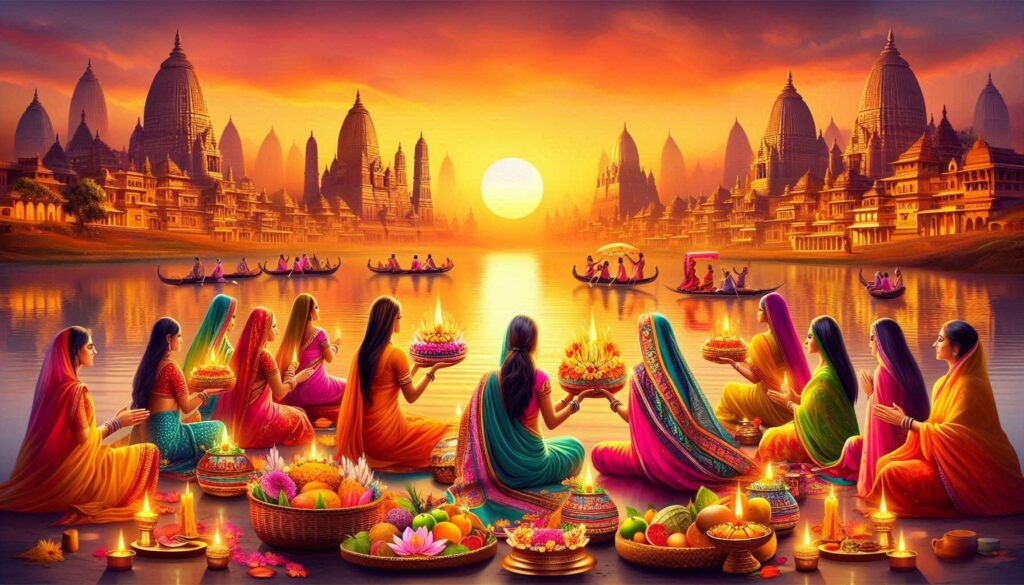Chhath Puja is a significant festival in Indian culture, celebrated with great enthusiasm, especially in the states of Bihar, Jharkhand, Uttar Pradesh, and Nepal. This festival is dedicated to the Sun God (Surya) and Chhathi Maiya (the Goddess associated with the festival), and it involves the tradition of offering prayers to the Sun. Chhath Puja lasts for four days, during which devotees (vratis) perform rigorous penance and pray for the well-being, prosperity, and happiness of their families.
Importance of Chhath Puja
The main purpose of Chhath Puja is to worship the Sun God to attain health, vitality, and success. The Sun, regarded as the life-giver of nature, is worshipped to invoke positive and pure energy. The primary goal of this festival is spiritual purification, sanctity, and the fulfillment of wishes.
Mythological Stories Associated with Chhath Puja
Several mythological tales are associated with Chhath Puja. One of the most popular stories is related to the Pandavas during their exile, where Draupadi observed the Chhath Puja to worship the Sun God, which restored the lost prosperity of the Pandavas. According to another tale, Lord Rama and Mata Sita performed this worship upon returning to Ayodhya and observed the fast on the sixth day of the waxing moon in the month of Kartik.
Dates and Sequence of the Four-Day Festival
- Nahay Khay (First Day):
The first day of Chhath Puja is known as Nahay Khay. On this day, devotees take a holy dip in a river or pond and consume a pure meal. Typically, they eat bottle gourd and split gram dal, which is sattvic food. This day marks the beginning of the fast, and devotees avoid onions and garlic. - Kharna (Second Day):
The second day is called Kharna. On this day, devotees observe a full-day fast without water and, in the evening, after performing rituals, they consume a meal of kheer (rice pudding), roti, and fruits. After this, the devotees begin a 36-hour strict fast, abstaining from both food and water. - Sandhya Arghya (Third Day):
On the third day, devotees offer prayers to the setting sun (Sandhya Arghya). Devotees gather by the riverside or pond and offer arghya (a sacred offering) to the Sun God with hands folded. The offering includes sugarcane, coconut, and various fruits, along with the traditional sweet called “thekua.” Family members often participate in this day’s rituals. - Usha Arghya (Fourth Day):
On the fourth and final day, devotees offer arghya to the rising sun (Usha Arghya). This marks the conclusion of the Chhath Puja. After the offerings, devotees break their fast and partake in the prasadam. Families and friends share blessings and partake in the celebratory meal.
Rituals of Chhath Puja
During Chhath Puja, cleanliness is of utmost importance. Devotees use raw bamboo baskets to carry the offerings and emphasize the use of sattvic foods, including thekua, rice laddus, and seasonal fruits. When offering arghya, devotees stand in water with folded hands, invoking the Sun God with deep devotion. Ganga water is often included in the offerings.
Rules and Precautions for Chhath Puja
- Devotees must adhere to strict regulations during the fast, consuming only pure, sattvic food and maintaining a high level of spiritual purity.
- Cleanliness is a core aspect of this festival, and all offerings should be prepared with devotion and care.
- During the fast, devotees often sleep on the ground, sacrificing comfort in their devotion.
Offerings Made During Chhath Puja
Special offerings play a vital role in Chhath Puja, including thekua, rice laddus, and seasonal fruits such as sugarcane, coconut, and bananas. All these offerings are dedicated to the Sun God and Chhathi Maiya. Thekua, made from wheat flour and jaggery, is considered a principal offering during the festival.
Significance and Benefits of Chhath Puja
Chhath Puja is not merely a religious ritual but a day that strengthens the bond between families. Devotees pray for the longevity and prosperity of their family members. It is believed that performing this fast leads to blessings of children, wealth, and health.
The festival also promotes an appreciation for nature, as it encourages gathering near rivers, ponds, and water bodies, symbolizing a connection with the environment.
Chhath Puja is an important and sacred festival in Indian culture, reflecting the essential role of nature and family in our lives. This four-day festival exemplifies the devotee's dedication and patience while also teaching us the values of respect, spirituality, and dedication towards nature and family.
